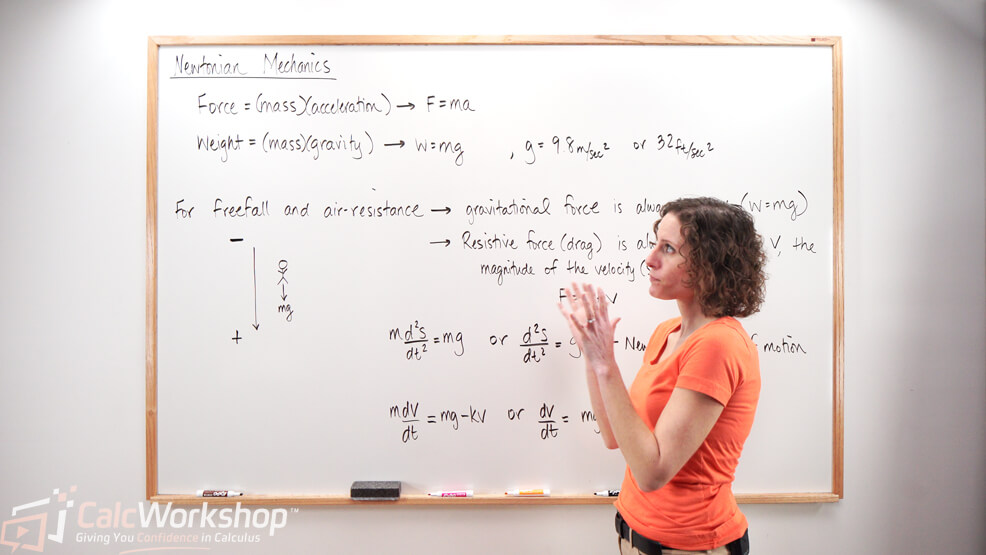Did you know that differential equations can be used to model and describe various physical situations? In fact, a key application of first-order differential equations is modeling phenomena such as:

Jenn, Founder Calcworkshop®, 15+ Years Experience (Licensed & Certified Teacher)
- Growth and decay
- Compound interest
- Population dynamics
- Mixing problems
- Falling objects
- Temperature changes
It’s important to note that both linear and nonlinear models play a crucial role in making accurate predictions about real-world situations and scenarios.
Before diving into our video lesson, let’s briefly explore each type of model.
Exponential Growth and Decay
In many applications, the rate of change of a variable \(y\) is proportional to the value of \(y\).
In fact, if \(\mathrm{y}\) is a function of time, then the proportionality can be written as \(\frac{d y}{d t}=k y\), which after using separation of variables we get, \(y=c e^{k t}\), where \(\mathrm{c}\) is the initial value of \(\mathrm{y}, \mathrm{k}\) is the proportionality constant, and if \(k>0\) exponential growth will occur and when \(k<0\) there is exponential decay.
Compound Interest
Therefore, just as we saw in single variable calculus, we can use the natural exponential function, e, for such problems like radioactive half-life, bacterial culture growth, and even comparing continuous and monthly compounding.
Suppose \(\mathrm{P}\) dollars is deposited at an annual interest rate \(\mathrm{r}\), how can we determine the balance after a period of time if interest accumulates in the account?
Well, the answer depends on the number of times, \(\mathrm{n}\), the interest is compounded.
So, if \(\mathrm{P}\) dollars is deposited in an account (principle balance) paying an annual rate of interest \(\mathrm{r}\) compounded (paid) n times per year, then after \(\mathrm{t}\) years the account will contain a final amount, \(\mathrm{A}\) dollars, where \(A=P\left(1+\frac{r}{n}\right)^{t n}\).
But sometimes, rather than compound interest at specific intervals like weekly, monthly, quarterly, or annually, continuous compounding is used. This means that if we allow \(\mathrm{n}\) to approach infinity (i.e., accruing interest at the smallest possible interval), then
\begin{align*}
A=\lim _{n \rightarrow \infty}\left(P\left(1+\frac{r}{n}\right)^{t n}\right) \Rightarrow A=P e^{r t}
\end{align*}
Population Problems
Population models, or the study of fluctuating populations, analyzes how a population changes over time, either due to birth and death rates or migration, such as immigration (entering a region) or emigration (exiting a region).
The differential equations that best models shifting population are logistic growth as well as harvest models.
Sometimes the situation will call for a simple separable differential equation, resulting in a general formula of \(P=c e^{r t}\), where \(\mathrm{P}\) represents the population, \(\mathrm{r}\) is the rate of change and \(\mathrm{t}\) is time.
Whereas, other conditions will follow a more complicated path, resulting in an equation such as \(\frac{d P}{d t}=P(a-b P) \pm h\) where \(h\) represents immigration or emigration
This particular formula should seem familiar, as it is a variation of the logistic equation from single variable calculus, where \(\frac{d P}{d t}=P(a-b P)\) and \(k=\frac{a}{b}\) is the called the carrying capacity or the limiting capacity.
Mixture Problems
Mixture or dilution problems involve a formula that will express the amount a substance in solution as a function of time, \(t\), where this amount is changing instantaneously with time.
In essence, a liquid will enter and leave a tank and a substance is subsequently dissolved in the liquid and the goal is to determine the appropriate concentration of the substance in the liquid.
Thus, the rate of change in the amount of substance in the tank is equal to the input rate minus the output rate, where the input and output rates are a product of the flow rate and concentration.
Mixture problems are modeled by the differential equation shown below and are best solved using the integrating factor method.
\begin{align*}
\frac{d x}{d t}=(\text { input amount })(\text { input rate })-\frac{\text { amount of substance }}{(\text { fluid amount }) \pm(\text { rate change }) t}(\text { output rate })
\end{align*}
Falling Bodies and Air Resistance
These modeling problems deal with gravity and falling bodies and utilize Newton’s second law of motion as it helps us to makes sense of the sign of the velocity (up or down) depending on the force of air resistance. In particular, it is important for a parachutist to know when to open their chute as the optimal moment is at terminal velocity which is the moment when an object is neither increasing nor decreasing speed.
Well, terminal velocity is achieved when the air resistance equals the magnitude of the weight of the falling object; therefore, we need to utilize Newton’s laws of motion: inertia, force, and action and reaction, to help us make sense of things.
Newton’s Laws of Motion
An object at rest remains at rest and an object in motion remains in motion.
The acceleration of an object depends on the mass of the object and the amount of force applied to it.
When one object exerts a force on another object, the second object exerts an equal and opposite force on the first object.
Consequently, the acceleration of an object depends on the mass of the object and the amount of force applied and is explained using the equation Force \(=(\) mass \()\) (acceleration \()\)
This equation tells us that an object subjected to some external force will accelerate, it is important to note that the acceleration is proportional to the size of the force. And we can use vectors to describe the force, acceleration, and velocity of an object, as they help us to describe how an object moves.
Temperature Problems
Another important linear model involves temperature.
In fact, under certain conditions, the rate of change of the temperature of a body differs proportionally to the difference in temperature between it and the surrounding medium it is immersed in.
This type of problem is called Newton’s Law of Cooling or warming, and is demonstrated by the following differential equation
\begin{align*}
\frac{d T}{d t}=-k\left(T_{\text {Body }}-T_{\text {medium }}\right)
\end{align*}
It is important to note that the surrounding medium is commonly referred to as the ambient temperature, therefore many textbooks will use the following formula for Newton’s Law of Cooling
\begin{align*}
\frac{d T}{d t}=-k\left(T-T_{a}\right)
\end{align*}
Consequently, if we apply the separation of variables technique, we have the following formula
\(T=T_{M}+\left(T_{B}-T_{M}\right) e^{-k t}\)
or \(T=T_{a}+\left(T_{0}-T_{a}\right) e^{-k t}\)
where \(T_{0}\) is the initial temperature and \(T_{a}\) is the ambient temperature.
Next Steps
Together we will look at how to use mathematical models involving first order differential equations that help us to explain growth and decay, interest, cooling or warming of bodies, mixtures, and falling objects.
It’s going to be great, so let’s jump right in!
Video Tutorial w/ Full Lesson & Detailed Examples

Get access to all the courses and over 450 HD videos with your subscription
Monthly and Yearly Plans Available
Still wondering if CalcWorkshop is right for you?
Take a Tour and find out how a membership can take the struggle out of learning math.